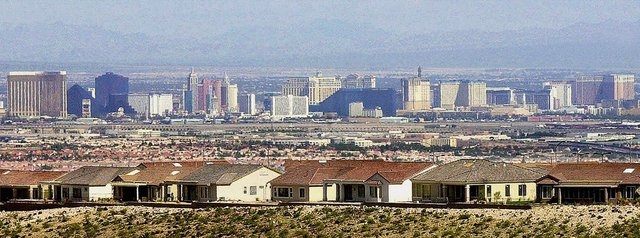Glory days: Four veteran Las Vegas developers recall major projects
They designed, built or marketed more than 23,000 hotel rooms, 40,000 homes, 15 master-planned housing communities and even a few prisons, schools, banks and grocery stores.
And on Thursday, the four veteran developers came together at the Southern Nevada Home Builders Association’s 60th Anniversary dinner at The Orleans to share war stories from four decades in local real estate, and to forecast what’s ahead as Southern Nevada continues to grow.
They talked first about a city few locals today would recognize.
Ray Landry, a former sales and marketing executive who signed on with Pardee Homes as it planned Spring Valley on the southwest side in the 1970s, remembered how simple consumer tastes were back then: Shag carpet! Formica countertops! Two-car garages! The horror! And he recalled how you could see the Strip from Rainbow Boulevard, because no other development blocked the view.
Then there was the time Steve Wynn weighed developing land that Larry Canarelli, founder of American West Homes, owned on Whitney Mesa, near Russell Road and U.S. Highway 95. Canarelli practically looked deflated all over again as he described the day Wynn told him he was taking Shadow Creek Golf Course north of town.
And Tito Tiberti, president and CEO of J.A. Tiberti Construction, did some quick math to tell the crowd of 250 that Howard Hughes bought the 25,000 acres that would become Summerlin in 1951 — for $3.98 an acre. That’s just under $36 an acre in 2013 dollars.
Just how wild and woolly was Las Vegas development back in the day? Consider that some of the land acquisitions American Nevada Co. made to build Green Valley in the 1970s were drawn up over meals on paper napkins, said panel moderator Mark Fine, who helped develop the master plan.
Those were the days, right? But things are different now, and panelists spent just as much time looking forward, summing up issues locals have to overcome to not just grow, but to grow sensibly.
For starters, it’s not as easy to build anything anymore, especially since the recession, panelists agreed. Part of it is basic economics, but the town also seems to have lost a bit of its can-do attitude, said Tony Marnell, the architect who helped design and build hotel-casinos ranging from The Mirage to M Resort.
When he worked on The Mirage in the late 1980s, Las Vegas was “a community that got things done, and there were people who made things get done,” Marnell recalled. “Now, we have a community where we need to think about things a little bit. We don’t have that cohesion right now, and rightly so. We had five years of very interesting times in our country, and it’s kind of been everybody for themselves. We might want to figure out as a community how to get our momentum back.”
More up-and-coming risk takers would make a difference, said Landry, who helped open more than 100 new-home subdivisions for a total of more than 25,000 homes in his 35 years at Pardee.
“The younger generation is waiting for something to happen, but you have to make it happen,” he said. “You have to go beyond your job description and get involved in the community.”
Las Vegas does have one big advantage — global name recognition, Fine said. But the city also has its share of headwinds.
Water will always be an issue. Residents need to, well, drink, and the city’s massive hotels need equally massive fire-sprinkler systems, Tiberti said. Still, Southern Nevada has done an admirable job of conserving, Canarelli said, and water use per capita is down significantly in recent years.
New supplies, potentially from Northern Nevada or from desalination plants on the California coast, will help as well, he said.
More worrisome to panelists is land supply. At current development rates, the city has maybe five to 10 years remaining, said Canarelli, whose company has built about 16,000 homes in Southern Nevada.
“There’s no land left. All the builders know it, and it is really frightening,” he said.
Builders need to work with municipal officials to “really embrace New Urbanism,” a type of development that focuses on pedestrian-friendly master plans, higher-density housing and building job centers nearby, Canarelli said.
Contact reporter Jennifer Robison at jrobison@reviewjournal.com. Follow @J_Robison1 on Twitter.

















